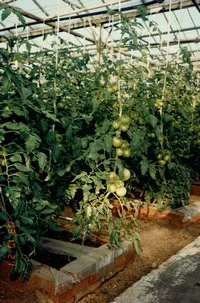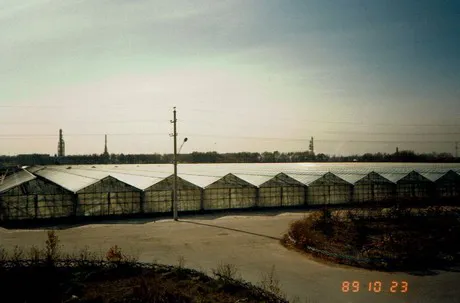Only 2 weeks ago we published about
China's biggest smart greenhouse, being built in Daqing. The first stage of the modern greenhouse is over 12 hectares. It's not the first one though: the Daqing area has an extensive horticultural history. Let's go back to the eighties!
Modern greenhouses
These photos were sent to us by Arjen Stolk, who took them himself. Celebrating his 68th birthday today, Arjen retired a couple of years ago, but back in the 1980s he traveled the world selling seeds. The pictures show a different type of building than the well-known Chinese solar greenhouses. Even thought the photos are almost 30 years old, the greenhouses cover quite an acreage, and a peek inside the tomato greenhouse also shows a pretty professional cultivation. True - we do not see any Meteor gutters, nor are we aware of the Van der Knaap cocos, but the quality is remarkable.
"This was extraordinary, especially for those days", Arjen remembers. "I used to sell tomato and cucumber seeds all over Asia; in Indonesia, Japan, China, Malaysia, India - you name it. Back then there was hardly any covered cultivation. The farms were built in the Daqing region because they have oil over there. The oil was being used to heat the greenhouses." The Daqing area, being close to the Russian border and situated even more north than Vladivostok, knows extreme temperatures, especially in winter.
Developing market

Arjen has been traveling the world of fruits and vegetables for 35 years. The first time he arrived in China, in the mid-1980s, the blue Yat-Sen Suit still was the common dress code and Arjen was an attraction among the residents. Unable to speak Chinese himself, he hired a translator from the Ministry of Foreign Trade & Affairs. "One of my first visits was to a complex near Beijing. It was over 10 hectares, built by a Romanian company. In the years before, many Dutch greenhouses were exported to Romania. They learned the business themselves and started exporting to China."
The greenhouse manager was trained in Romania as well. "He was used to growing with Dutch seeds as well, but didn't get the budget, because the seeds were way too expensive. I remember giving them a complete greenhouse for trial for free, to convince them of the value. There was no other way to explain them why to pay over 200 times the price they were used to paying. The next season, they were my customer." In those days, breeding was unknown. "Nobody traveled here - not to Japan, not to China and especially not to the Daqing region. I only remember seeing Rob Baan there, who was also in the seeding business."
After his career in the seeds industry, Arjen lost his heart to the fresh produce trade, in which he worked for over 20 years. "Much more dynamic and much faster", he recalls. "The complete trade can be finished before you have your morning coffee, while it might take years for you to sell your seeds."
Nowadays Arjen has retired, living in Bleiswijk, and he's done traveling the world. Although... he did pay a visit to the recent Grand Prix in Dubai, while visiting former customers. "That's what I used to do back in the days as well: the Grand Prix of Japan, Malaysia, Bahrain. Why not, if you were there already?"
For more information (or birthday wishes):

 Arjen has been traveling the world of fruits and vegetables for 35 years. The first time he arrived in China, in the mid-1980s, the blue Yat-Sen Suit still was the common dress code and Arjen was an attraction among the residents. Unable to speak Chinese himself, he hired a translator from the Ministry of Foreign Trade & Affairs. "One of my first visits was to a complex near Beijing. It was over 10 hectares, built by a Romanian company. In the years before, many Dutch greenhouses were exported to Romania. They learned the business themselves and started exporting to China."
Arjen has been traveling the world of fruits and vegetables for 35 years. The first time he arrived in China, in the mid-1980s, the blue Yat-Sen Suit still was the common dress code and Arjen was an attraction among the residents. Unable to speak Chinese himself, he hired a translator from the Ministry of Foreign Trade & Affairs. "One of my first visits was to a complex near Beijing. It was over 10 hectares, built by a Romanian company. In the years before, many Dutch greenhouses were exported to Romania. They learned the business themselves and started exporting to China." 